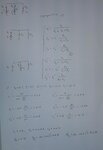Follow along with the video below to see how to install our site as a web app on your home screen.
Note: This feature may not be available in some browsers.
Yeah, this also the part that confuses me. I don't know if it is a typo or what.But I don't know how he arrived at 12 watts for the second case.

View attachment 144387
Hello!
I'am having difficulty understanding the statements in the encircled part. What internal losses is it talking about? and how did it come up with its formula for calculating it? TIA.




When R = 0, 12 volts is across the 20 ohm resistor, so the wasted power is 7.2 watts. When R = 20 ohms, V = 8 volts and 4 volts is across resistor R = 20 ohms, which causes 0.8 watts wasted. 8 volts across the 20 ohm resistor causes 3.2 watts of wasted power. Added together we get 4.0 wasted watts when R = 20 ohms.Ratch
Your last calculation is not correct. If R=20 ohm, using your equation to calculate V at the connection point
of the three resistors, we obtain V=7 V. Then
Pr1 = (12-7)^2/20 = 1.25 W
Pr2 = (7-8)^2/10 = 0.1 W
Pr3 = (7)^2/20 = 2.45 W
then the wasted power is Pr1+Pr3 = 3.7 W. Node analysis and current branch analysis of course must match each other.
By the way, when V=8 V, there is no power dissipated onto the load regardless its ohmic value